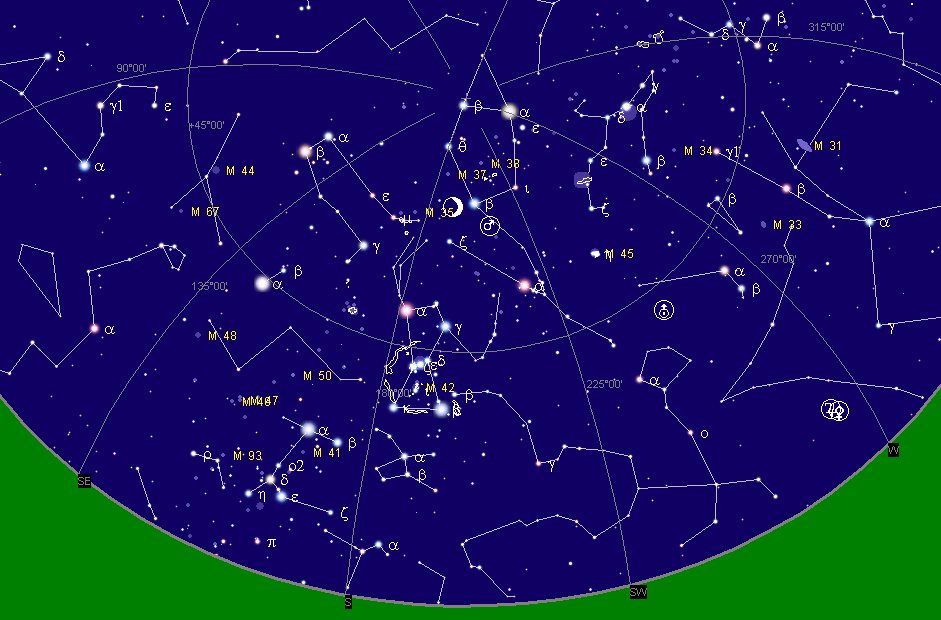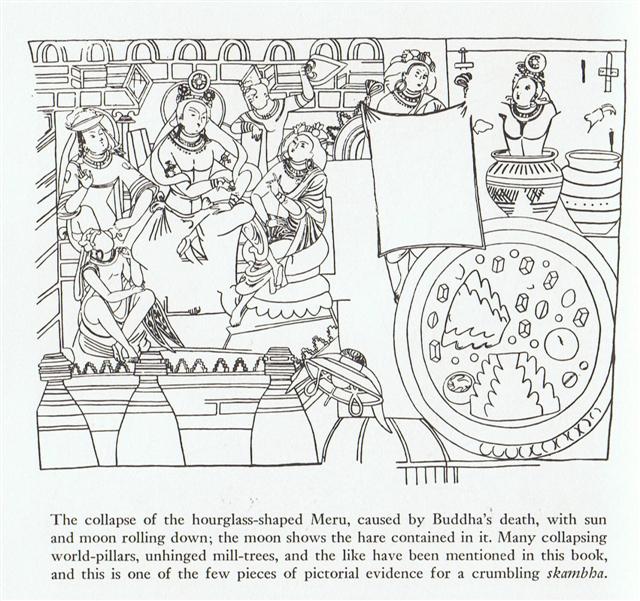2. So it is necessary to go back and look again.
The computer program Cartes du Ciel makes it easy to move back and ahead in time-space (pacha). ... Space and time are a single, related concept in Runasimi [the language of the Inca people], represented by one word, pacha, which can also mean 'world' and 'universe'. The image of time familiar to Waman Puma was static and spatial: one could travel in time as one travels over earth - the structure, the geography, remaining unchanged. To him it does not matter that he shows Inka Wayna Qhapaq, who died in 1525, talking to Spaniards who did not arrive until 1532. Wayna Qhapaq was the last Inca to rule an undivided empire: he is therefore the archetype, and it must be he who asks the Spaniards. 'Do you eat gold?' ... This is an overview of the situation in the last night of February (in the current year 2023 AD):
The object I assumed was Venus appears here instead to indicate the Moon. But certainly the Moon was not close in the evening sky in the west. However, Venus in conjunction with Jupiter below Pisces at far right in the map tells us that my 'Mars' must have been some other object. Investigating further I arrived at the following view for February 1 (18.30):
Judging from the string of planets visualizing the path of the ecliptic, with Mars and Uranus close to the Pleiades (M45) and with Venus above Saturn close to the horizon in the west, it seems that it might have been Saturn (rather than Mars) which I had observed here late in February. This exercise made me reevaluate some of my ideas regarding the contrast between the drawings of Hevelius and the perspective of the Arabs: ... We inherited our astronomy from the Arabs and they were writing (and reading) from right to left, which fact could explain why we are visualizing the night sky with right ascension time running from right to the left ... From my own very limited expericence in these matters it now seems natural to look at the star charts in the evenings when the stars will begin to reappear again in the west rather than to get up early in the mornings to look at the last stars before the rays of the rising Sun would make them vanish. And then it becomes obvious that such stars which rose early in the mornings would also descend early at the horizon in the west in the evenings. Which means that when the 'eldest' just was out of view in the west his 'younger' companions would still be in full view. ... The four males and the four females were couples in consequence of their lower, i.e. of their sexual parts. The four males were man and woman, and the four females were woman and man. In the case of the males it was the man, and in the case of the females it was the woman, who played the dominant role. They coupled and became pregnant each in him or herself, and so produced their offspring. But in the fullness of time an obscure instinct led the eldest of them towards the anthill which had been occupied by the Nummo. He wore on his head a head-dress and to protect him from the sun, the wooden bowl he used for his food. He put his two feet into the opening of the anthill, that is of the earth's womb, and sank in slowly as if for a parturition a tergo. The whole of him thus entered into the earth, and his head itself disappeared. But he left on the ground, as evidence of his passage into that world, the bowl which had caught on the edges of the opening. All that remained on the anthill was the round wooden bowl, still bearing traces of the food and the finger-prints of its vanished owner, symbol of his body and of his human nature, as, in the animal world, is the skin which a reptile has shed ... Presumably this 'round wooden bowl' which did not enter into the womb of mother earth represented the domain of the circumpolar stars, such stars which never went down. ... ancient Egyptians observed the stars and the circumpolar stars they regarded as qualitatively different from the ordinary stars which arrived at the eastern horizon and later disappeard behind the western horizon. The circumpolar stars had a circular motion, whereas the ordinary ones went straight across the sky ...
... The inscriptions relating to one of the very earliest of the illustrations refers to Horus, 'the great god, the light of the heavens, the lord of Edfû, the bright ray which appears on the horizon'. The myth, therefore, I take it, simply means that the rising sun destroys the circumpolar stars. These stars are represented in the earliest forms of the myth either by the crocodile or the hippopotamus; of course they disappeared (or were killed) at sunrise. Horus, the bright ray on the horizon, is victorious by destroying the crocodile and the hippopotamus, which represent the powers of darkness ...
|
.jpg)



